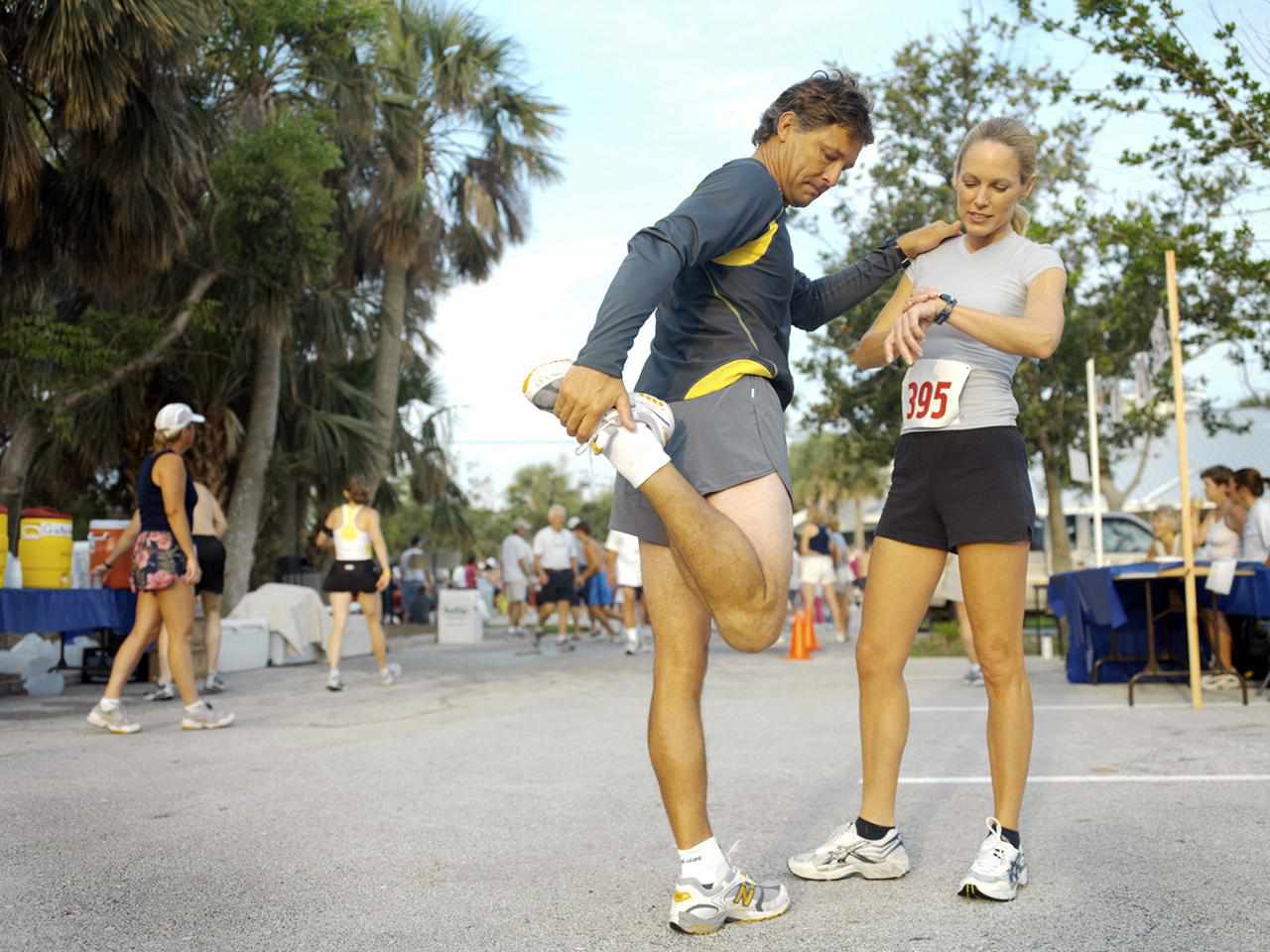

Featured
How To Improve Your Half Marathon Time
Modified: January 2, 2024
Looking for featured tips to improve your half marathon time? Discover effective strategies and techniques in this comprehensive guide to boost your race performance.
Introduction
Are you looking to improve your half marathon time and achieve your personal best? Whether you’re a seasoned runner or just starting out on your running journey, it’s natural to want to challenge yourself and find ways to enhance your performance. The half marathon, a 13.1-mile race, requires both physical and mental endurance. With the right training and strategies, you can push your limits and cross that finish line with a sense of accomplishment.
Improving your half marathon time requires a combination of factors, including setting clear goals, following a structured training plan, incorporating speed workouts, focusing on strength training, improving your running form, fueling your body properly, staying consistent with cross-training, prioritizing recovery and rest, and implementing mental strategies for improved performance.
In this article, we will delve into each of these areas and provide practical tips and techniques to help you improve your half marathon time. From training methods to nutrition to mindset, we will cover it all and guide you towards achieving your running goals. So, lace up your running shoes, get ready to hit the pavement, and let’s dive into the world of half marathon training and performance improvement.
Set Clear Goals
When it comes to improving your half marathon time, the first step is to set clear and specific goals. Goal setting provides you with a sense of direction and motivation to keep pushing forward throughout your training. Here are some tips to help you set effective goals:
- Define Your Main Objective: Start by determining your ultimate goal for the half marathon. Do you want to beat your previous time, achieve a new personal record, or simply complete the race? Knowing your main objective will help guide your training and focus.
- Set SMART Goals: It’s crucial to set goals that are Specific, Measurable, Attainable, Relevant, and Time-bound (SMART). For example, instead of aiming to “improve my half marathon time,” a SMART goal would be to “reduce my half marathon time by 5 minutes within 3 months of training.”
- Break it Down: Once you have your main goal, break it down into smaller milestones. This makes your overall goal more manageable and helps you track progress along the way. For example, if your main goal is to reduce your time by 5 minutes, set smaller goals to improve your speed and endurance each week.
- Write it Down: Research shows that writing down your goals increases the likelihood of achieving them. Put your goals on paper or create a digital document and place it somewhere visible. This constant reminder will help keep you focused and accountable.
- Stay Flexible: While it’s important to have a set goal, be open to adjusting it if necessary. Factors such as injuries, weather conditions, and unforeseen circumstances may require you to modify your goals along the way. Adaptability is key in maintaining a positive mindset and continuing to progress.
By setting clear goals, you provide yourself with a roadmap towards achieving your desired outcome. Keep these tips in mind as you move forward with your half marathon training, and let your goals serve as a constant source of motivation and inspiration.
Follow a Structured Training Plan
One of the keys to improving your half marathon time is following a structured training plan. A well-designed plan will help you gradually build your endurance, speed, and strength while minimizing the risk of injury. Here are some guidelines to help you create or choose a training plan:
- Determine Your Current Fitness Level: Before selecting a training plan, it’s important to assess your current fitness level. Consider how often you currently run, your average pace, and your longest run to date. This will help you choose a plan that aligns with your abilities and goals.
- Choose a Plan that Matches Your Goals: Look for a training plan that aligns with your specific objectives. Some plans focus on increasing speed, while others prioritize building endurance. Choose one that suits your desired outcome and the time you have available to devote to training.
- Consider the Plan’s Duration: Take into account the length of the training plan. Some plans range from 12 weeks to 16 weeks, depending on your starting point and the level of improvement you’re aiming for. Make sure the timeline fits your schedule and allows for gradual progression.
- Gradual Progression: Look for a plan that incorporates gradual progression in terms of mileage, intensity, and speed. Pushing yourself too hard too soon can lead to injuries and burnout. A well-structured plan will include a mix of easy runs, long runs, tempo runs, and rest days for optimal improvement.
- Listen to Your Body: While it’s important to follow a plan, it’s equally crucial to listen to your body. If you are experiencing pain or exhaustion, it’s important to rest and recover. Overtraining can lead to injuries and set you back in your training.
- Track Your Progress: Keep a record of your runs and monitor your progress along the way. This will not only help you stay motivated, but it will also allow you to make adjustments to your training plan if needed. Take note of your pace, distance, and how you feel during and after each run.
Following a well-structured training plan will keep you accountable, ensure gradual progression, and help you reach your half marathon goals. Remember, consistency is key, so make sure to stick to your plan and adjust it as necessary based on your individual needs and progress.
Incorporate Speed Workouts
If you want to improve your half marathon time, incorporating speed workouts into your training regimen is crucial. Speed workouts help increase your running pace, build endurance, and improve your overall performance. Here are some key tips to effectively incorporate speed workouts into your training:
- Start with a Warm-up: Before diving into intense speed work, warm up properly to prepare your muscles and reduce the risk of injury. Begin with dynamic stretches, such as leg swings and high knees, followed by a light jog to get your blood flowing.
- Interval Training: Interval training involves alternating between high-intensity efforts and recovery periods. One common type of interval workout is the “Fartlek” run, where you increase your pace for a set distance or time, followed by an easy jog or walk to recover. Another popular interval workout is the “Yasso 800s,” where you run 800 meters at a faster pace and then recover for the same duration. Repeat this cycle multiple times.
- Hill Repeats: Hill repeats are an excellent way to build strength and speed. Find a hill with a moderate incline and sprint up it at a challenging pace, then jog back down to recover. Repeat this 5-10 times, gradually increasing the number of repetitions as you get stronger.
- Tempo Runs: Tempo runs involve running at a steady pace that is slightly faster than your comfortable pace. This challenges your body to maintain a faster speed over a longer distance, improving your endurance and pace. Start with shorter tempo runs and gradually increase the distance as you progress.
- Track Intervals: If you have access to a running track, use it for interval training. Run a predetermined distance, such as 400 meters or 800 meters, at a faster pace, then recover with a slow jog or walk for an equal amount of time. Repeat this cycle several times to improve your speed and stamina.
- Cooldown and Recovery: After completing your speed workout, don’t forget to allow time for a proper cooldown. This could include a light jog followed by static stretches to prevent muscle tightness and aid in recovery. Giving your body adequate rest and recovery time is essential for optimal performance.
Remember, speed workouts are intense, so it’s important to listen to your body and gradually increase the intensity and volume of these workouts over time. Incorporate speed workouts into your training plan once or twice a week, giving your body ample time to recover between sessions.
Focus on Strength Training
When it comes to improving your half marathon time, don’t neglect the importance of strength training. Building strength in your muscles can help improve your running efficiency, prevent injuries, and enhance your overall performance. Here are some key points to focus on when incorporating strength training into your routine:
- Target Key Muscles: While running primarily targets the muscles in your lower body, it’s important to engage in full-body strength training. Focus on exercises that target your core, glutes, hips, and legs. Examples include squats, lunges, deadlifts, hip bridges, planks, and lateral leg raises.
- Include Resistance Training: Incorporate resistance training into your strength routine to challenge your muscles and improve their endurance. Use dumbbells, resistance bands, or weight machines to add resistance to exercises like squats, lunges, and calf raises.
- Prioritize Stability and Balance: Strong stabilizer muscles are essential for maintaining proper form and reducing the risk of injuries. Include exercises that improve balance and stability, such as single-leg squats, side planks, and stability ball exercises.
- Don’t Forget Upper Body: While the lower body is essential for running, a strong upper body can help with posture and overall body alignment. Include exercises like push-ups, rows, and shoulder presses to strengthen your arms, shoulders, and back.
- Consider Plyometric Exercises: Plyometric exercises involve explosive movements that can improve power and speed. Incorporate exercises such as box jumps, jump squats, and burpees to enhance your running performance.
- Balance Strength and Running Workouts: It’s important to find a balance between your strength training and running workouts. Avoid overtraining by spacing out your strength sessions and allowing adequate recovery time between workouts.
- Seek Guidance: If you’re new to strength training or unsure where to start, consider consulting a certified strength and conditioning specialist or a personal trainer. They can help create a tailored strength training program to complement your running goals.
Remember, consistency is key when it comes to strength training. Aim to incorporate strength sessions into your routine at least two to three times a week. As you build strength, you’ll notice improved running economy, reduced fatigue, and enhanced performance during your half marathon training and race day.
Improve Your Running Form
Improving your running form can have a significant impact on your half marathon performance. Proper form not only enhances efficiency but also reduces the risk of injuries. Here are some tips to help you improve your running form:
- Maintain Proper Posture: Stand tall with your head up, shoulders relaxed, and core engaged. Avoid leaning too far forward or backward as it can put unnecessary strain on your body.
- Focus on Footstrike: Aim for a midfoot or forefoot strike rather than a heel strike. This helps to distribute the impact of each step more evenly and allows for a more efficient transfer of energy.
- Shorten Your Stride: Avoid overstriding, which means landing your foot too far in front of your body. Instead, aim for a shorter stride length, allowing your feet to land closer to your body’s center of mass.
- Engage Your Arms: Swing your arms in a relaxed and controlled manner, keeping them bent at approximately 90 degrees. Your arm movement should be forward and backward, rather than across your body.
- Breathe Efficiently: Focus on deep belly breathing to supply your muscles with ample oxygen during your runs. Inhale through your nose and exhale through your mouth in a rhythm that feels natural to you.
- Engage Your Core: Keep your core muscles engaged by drawing your belly button in towards your spine. This helps stabilize your body and maintains proper alignment throughout your run.
- Stay Relaxed: Avoid tension in your upper body, including your neck, shoulders, and hands. Relax your face and jaw, keeping your hands loose and your fingers lightly clenched.
- Practice Good Cadence: Aim for a cadence of around 180 steps per minute. This promotes a quicker turnover, reducing the risk of overstriding and improving your running efficiency.
- Implement Drills and Exercises: Incorporate running drills and exercises into your training routine to improve your running form. These may include high knees, butt kicks, strides, and form-focused drills.
- Video Analysis: Consider recording yourself running or seek professional help for a video analysis of your running form. This can provide valuable insights into areas that need improvement and help you make necessary adjustments.
Remember that improving your running form takes time and practice. Focus on one aspect at a time and gradually incorporate changes into your running routine. By making adjustments and refining your form, you’ll become a more efficient runner and maximize your performance during your half marathon.
Fuel Your Body Properly
Proper nutrition is essential for optimal performance in any endurance event, including a half marathon. Fueling your body with the right nutrients before, during, and after your runs can improve your energy levels, endurance, and recovery. Here are some key tips to help you fuel your body properly:
- Prioritize Carbohydrates: Carbohydrates are your body’s primary source of energy. Include complex carbohydrates, such as whole grains, fruits, and vegetables, in your meals and snacks to provide a steady release of energy throughout the day.
- Time Your Meals: Eat a balanced meal containing carbohydrates, lean protein, and healthy fats 2-3 hours before your runs. This allows your body to digest and absorb the nutrients, providing you with sustained energy during your workout.
- Hydrate Properly: Hydration is key for optimal performance. Drink plenty of water throughout the day and ensure you are well-hydrated before, during, and after your runs. Consider electrolyte-replenishing drinks for intense or prolonged workouts.
- Pre-Run Snack: If you’re running first thing in the morning or need a quick energy boost, have a small pre-run snack consisting of easily digestible carbohydrates. Examples include a banana, a piece of toast with nut butter, or a handful of dried fruit.
- During-Run Fuel: For long runs lasting over an hour, fuel your body with carbohydrates during the run. This can include energy gels, sports drinks, or easily digestible snacks like energy bars or dates.
- Post-Run Recovery: After your run, prioritize replenishing your energy stores and aiding in recovery. Consume a mix of carbohydrates and protein within 30-60 minutes of finishing your run. This can be in the form of a protein shake, yogurt with fresh fruit, or a small meal containing lean protein and complex carbohydrates.
- Listen to Your Body: Pay attention to how different foods and hydration strategies make you feel during your training. Each person is unique, and it’s important to find the nutrition plan that works best for you.
- Consult a Registered Dietitian: If you have specific dietary needs or are unsure about your nutritional requirements, consider seeking guidance from a registered dietitian who specializes in sports nutrition. They can help develop an individualized plan based on your goals and preferences.
Remember, nutrition plays a crucial role in your half marathon training and performance. Experiment with different foods and strategies during your training runs to find what works best for you. Proper fueling will provide you with the energy you need to perform at your best on race day.
Stay Consistent with Cross-Training
While running is a fundamental component of half marathon training, incorporating cross-training activities into your routine can greatly benefit your overall performance. Cross-training involves engaging in different forms of exercise, other than running, to enhance your strength, flexibility, and overall fitness level. Here’s why staying consistent with cross-training is important:
- Prevent Overuse Injuries: Running puts stress on specific muscles and joints. By incorporating cross-training activities, you can give these areas a break while still maintaining fitness. This helps prevent overuse injuries and improves overall muscle balance.
- Improve Strength and Endurance: Cross-training activities such as cycling, swimming, or strength training can target different muscle groups that may not be fully engaged during running. Building strength in these areas can improve your overall running performance and endurance.
- Maintain Cardiovascular Fitness: Cross-training activities that elevate your heart rate, such as swimming or rowing, can help maintain your cardiovascular fitness without adding excessive stress to your running muscles and joints.
- Enhance Flexibility and Mobility: Activities like yoga, Pilates, or stretching routines can help improve flexibility, mobility, and range of motion. Enhanced flexibility can improve your running form and help prevent injuries.
- Break the Monotony: Cross-training adds variety to your training routine, preventing boredom and keeping you motivated. Trying new activities can inject a sense of fun and excitement into your overall training plan.
- Active Recovery: Cross-training activities can serve as active recovery days, allowing your body to recover from the impact of running while still engaging in low-impact activities that promote blood flow and aid in muscle repair.
- Efficient Time Management: Cross-training allows you to maximize your training time by focusing on other aspects of fitness, such as strength, flexibility, and cardiovascular fitness, all in one session.
- Individualize Your Training: Cross-training activities can be tailored to your specific needs and interests. Whether it’s swimming, cycling, yoga, or any other activity, choose what aligns with your goals and preferences.
Make cross-training a consistent part of your training plan by incorporating it 1-3 times a week, depending on your preferences and schedule. Experiment with different activities and find what works best for you. Remember, cross-training should complement your running, not replace it. Find the right balance that allows you to improve your overall fitness while still prioritizing your running workouts.
Prioritize Recovery and Rest
When it comes to improving your half marathon time, giving your body ample time to recover and rest is just as important as the training itself. Proper recovery allows your muscles to repair, adapt, and grow stronger, reducing the risk of injuries and improving overall performance. Here are some key points to prioritize recovery and rest in your training:
- Include Rest Days: Schedule regular rest days throughout your training plan. These days give your body a chance to recover and prevent overtraining. Listen to your body and take additional rest days if you feel excessively fatigued or experience any pain or discomfort.
- Get Adequate Sleep: Sleep is crucial for recovery and overall well-being. Aim for 7-9 hours of quality sleep each night to allow your body to repair and recharge. Establish a consistent sleep routine and create a sleep-friendly environment to optimize this vital aspect of recovery.
- Practice Active Recovery: Engage in low-intensity activities such as gentle stretching, foam rolling, or taking a walk on your rest days. Active recovery promotes blood flow, aids in muscle repair, and can help reduce muscle soreness.
- Listen to Your Body: Pay attention to any signs of overtraining or excessive fatigue. If you experience persistent muscle soreness, decreased performance, or prolonged fatigue, it may be a sign that your body needs more rest. Don’t be afraid to adjust your training plan accordingly.
- Nutrition for Recovery: Proper nutrition plays a key role in recovery. Make sure to refuel your body with a mix of carbohydrates and protein within 30-60 minutes after your runs. Consuming a balanced diet that includes a variety of fruits, vegetables, lean proteins, and healthy fats will provide the nutrients your body needs for optimal recovery.
- Hydration: Adequate hydration is essential for recovery. Drinking enough water throughout the day and replenishing electrolytes after your workouts will help replenish fluids lost during exercise and support efficient recovery.
- Reduce Stress: High levels of stress can hinder recovery and impact your performance. Incorporate stress management techniques like meditation, deep breathing exercises, or other activities that help you relax and unwind.
- Regular Massage or Self-Care Techniques: Consider regular sports massages or use self-care techniques such as foam rolling or using a massage ball to reduce muscle tension and promote muscle recovery.
- Periodize Your Training: Build recovery periods into your training plan to allow for gradual progression and prevent burnout. This may include easier weeks, lighter workout sessions, or planned deload weeks.
Remember, recovery is not a sign of weakness but a crucial component of your overall training. By prioritizing recovery and rest, you will promote improved performance, reduce the risk of injuries, and ensure long-term success in your half marathon journey.
Mental Strategies for Improved Performance
Running a half marathon is not just a physical challenge but also a mental one. Developing strong mental strategies can help you push through the tough moments, stay focused, and improve your overall performance. Here are some key mental strategies to incorporate into your training:
- Set Positive Affirmations: Use positive self-talk to boost your confidence and motivation. Repeat phrases such as “I am strong” or “I can do this” to overcome self-doubt and stay focused on your goals.
- Visualization: Visualize yourself successfully completing the half marathon. Picture yourself crossing the finish line feeling strong and accomplished. By visualizing your success, you train your mind to believe in your abilities.
- Break the Race Down: Instead of focusing on the entire distance of the half marathon, break it down into smaller segments or milestones. Focus on reaching each mile marker, or mentally divide the race into sections. This approach can make the race feel more manageable and less overwhelming.
- Stay Present and Mindful: Focus on the present moment during your runs and races. Pay attention to your breath, body sensations, and the environment around you. This helps to maintain mental clarity and prevent your mind from wandering to negative thoughts.
- Use Mantras: Create short, powerful phrases that help you stay focused and motivated. Repeat these mantras to yourself during challenging moments. Examples include “Stay strong,” “Keep pushing,” or “One step at a time.”
- Practice Mental Toughness: Pushing through discomfort and fatigue is crucial during a half marathon. Incorporate mental toughness exercises into your training, such as running in adverse weather conditions or challenging yourself with difficult workouts. This helps you build resilience and learn to embrace discomfort.
- Embrace a Growth Mindset: Adopt a growth mindset by focusing on progress rather than perfection. View challenges and setbacks as opportunities for learning and improvement. Embracing a positive and growth-oriented mindset can boost your confidence and motivation.
- Use Distraction Techniques: During long runs or challenging moments in a race, distract your mind from the discomfort by focusing on external stimuli. This can include observing nature, listening to music or podcasts, or engaging in positive conversations with fellow runners.
- Celebrate Small Victories: Acknowledge and celebrate your achievements during training and in races. Recognize the progress you’ve made, no matter how small, and give yourself credit for your dedication and hard work. Celebrating small victories boosts your confidence and motivates you to keep pushing forward.
- Visualize a Strong Finish: During the final stretch of your training runs or races, visualize your strong finish. Imagine yourself pushing through fatigue and crossing the finish line with a sense of accomplishment and pride. This mental image can provide an extra surge of motivation.
Remember, your mental state can significantly impact your physical performance. By incorporating these mental strategies into your training, you will develop greater mental resilience, focus, and determination to excel in your half marathon.
Conclusion
Congratulations! You’ve now gained valuable insights and strategies to help you improve your half marathon time. From setting clear goals and following a structured training plan to incorporating speed workouts, focusing on strength training, improving your running form, fueling your body properly, staying consistent with cross-training, prioritizing recovery and rest, and implementing mental strategies – you are equipped with the tools to take your running performance to new heights.
Remember, improvement takes time, dedication, and perseverance. Be patient with yourself as you progress through your training journey. Listen to your body, adapt your training plan as needed, and prioritize proper recovery and rest to prevent injuries and maintain your overall well-being.
As you lace up your running shoes and embark on your half marathon training, remember to stay motivated, keep a positive mindset, and celebrate your accomplishments along the way. Whether you’re aiming to beat your personal record, achieve a new milestone, or simply complete the race, every step forward is a step toward your own version of success.
So, commit to your training, stay consistent, and believe in your abilities. With perseverance, determination, and the strategies outlined in this article, you can reach your goals and cross that finish line with a sense of pride and accomplishment. Good luck on your half marathon journey!









